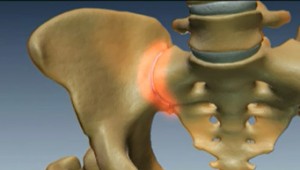Lower Back Pain and the Sacroiliac Joint
 Where is the sacroiliac joint?
Where is the sacroiliac joint?
The sacroiliac joint connects the last segment of the spine, the sacrum, to the pelvis. The integrity of the sacroiliac joint depends on strong ligaments that encase and cover the joint. These ligaments compress and stabilize the joint.
How the sacroiliac joint causes lower back pain?
The ligaments that encase the sacroiliac joint may be disrupted due to injury or degenerate due to age, allowing the joint to have excessive motion. This excessive motion may inflame and disrupt the joint and surrounding nerves.
Your physician may also refer to sacroiliac joint pain by other terms like sacroiliitis, SI joint degeneration, SI joint inflammation, SI joint syndrome, SI joint disruption and SI joint strain.
How do the symptoms of sacroiliac joint pain present?
The most common symptom of sacroiliac joint disorders is pain in the lower back, buttock and legs. This can present as sciatica like symptoms (leg pain, burning, numbness, and tingling) that mimic lumbar disc or radicular low back pain, pain that radiates down into the legs.
Causes of sacroiliac joint disorders
Causes of sacroiliac joint disorders can be split into five categories:
- Traumatic (lifting, fall, accident)
- Biomechanical (leg length discrepancy, prior lumbar fusion)
- Hormonal (pregnancy / childbirth)
- Inflammatory joint disease (sacroiliitis)
- Degeneration (age related wear and tear)
Diagnosing sacroiliac joint pain
In order to diagnose the sacroiliac joint as the pain generator, your physician will typically start with a history and a physical examination. During the physical examination, your physician may try to determine if the sacroiliac joint is the cause of pain through movement of the joint. If this joint movement recreates the pain, the SI joint may be the cause of the pain.
Your physician may also use X-rays, CT-scan or MRI to help diagnose the sacroiliac joint. It is also important to remember that more than one condition (like a disc problem) can co-exist with sacroiliac joint disorders.
Finally, your physician may request sacroiliac joint injections as a diagnostic test. Sacroiliac joint injections involve injecting a numbing medication into the sacroiliac joint. If the injection alleviates your symptoms, then your sacroiliac joint may be the likely source of your pain.
